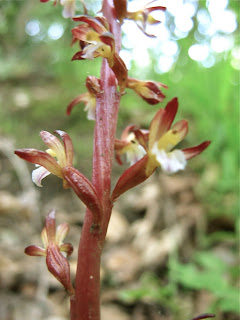Last year about this time as we were pulling French Broom from the sunny slope above the Evergreen Lane entrance a runner dashed by and asked if we had seen the orchid. Of course we had missed it on the way up, but on our return we found it close to the trail at one of the steep upgrades. It was about ten inches high, a thin pinkish stalk with many blossoms at the end of seed vessels that were just forming. Our May 5, 2010 photograph shows a robust plant standing alone except for the tendril of a native cucumber nearby.
The discovery of a native orchid anywhere in the East Bay ridge lands is important and Garber's orchid brought forth a flurry of attention and botanic consideration. Consensus said that we had come upon
corallorhiza maculata --Spotted Coralroot--though our orchid had no spots. Together with coralroot discoveries in Tilden and Joaquin Miller, Garber's orchid apparently brings up different taxonomic views and it is possible that there is as yet no settled opinion on the exact taxonomy here.
Because we knew where to look we were able to catch the return of our coralroot (a perennial) in 2011. We expected the long and moist spring to have produced an even more lavish plant than the 2010 orchid.
Photos show the emergence of a much smaller plant with far fewer blossoms and seed vessels. By mid-May, some desiccation was also visible. On July 4 we noticed that only the stalk remained, the entire reproductive cycle apparently having been completed.
So far, we have not located any other coralroots on the hillside or indeed in Garber Park as a whole. The characteristics of these plants are not well understood, but the appearance of even one in Garber is testimony to the native botanic richness of the park.
We will keep you posted as to further discoveries and hope that if you come upon this rare native, you will let us know in time to photograph it and add it to our gallery of documentation.





